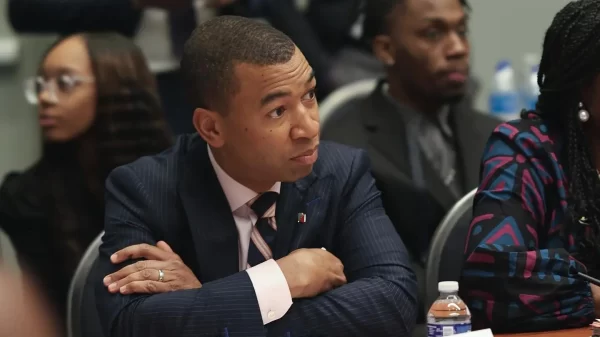External observers should be included on an “internal task force” formed in December to address deadly violence inside Alabama prisons, according to a criminal justice professor, who reinforced an earlier request from a group of prison reform advocates.
David Rembert is a research fellow at the Center for Justice Research at Texas Southern University, an Assistant Professor at Prairie A&M University and a member of the American Correctional Association. He formerly worked as a correctional officer with the Texas Department of Criminal Justice.
“That’s a no-no in criminal justice. You never say you’re going to do an internal task force,” Rembert told APR on Monday. “You already know what the results are going to look like.”
Alabama Department of Corrections commissioner Jeff Dunn announced formation of the internal task force on Dec. 9 following numerous inmate deaths in recent months, at least two the result of use-of-force incidents by correctional officers.
Inmate Michael Smith, 55, died on Dec. 5, five days after a “use of force” incident involving correctional officers at the Ventress Correctional Facility in Clayton. Two officers were placed on leave following that death.
Willie Leon Scott, 48, of Birmingham was pronounced dead on Dec. 6 at the Baptist Medical Center South in Montgomery following an “incident” on Dec. 4 at the Holman prison. ADOC has not stated what is believed to have occured in that death, which the department has said remains under investigation.
Steven Davis, 35, of Graysville, died on Oct. 5 after correctional officers “applied physical measures” on the inmate the day before. ADOC said at the time that Davis had attempted to strike an officer with weapons.
At least 27 Alabama prisoners died in 2019 as a result of homicide, drug overdoses or suicides, according to information gathered from ADOC, news accounts and tips reporters receive from other inmates and family members of the deceased inmates.
“Commissioner Dunn has directed the task force to assess measures including “Tactics and Techniques” reinforcement training programs, health and wellness interventions for correctional officers and staff, additional inmate rehabilitation programs and resources, and the reexamination of enhanced surveillance measures such as the possible use of body cameras by on-duty correctional officers,” the statement from ADOC on the task force reads. “Dunn has directed the new internal task force to integrate these actions into the ADOC’s three-year strategic plan.”
Alabamians for Fair Justice, a coalition of former prisoners, family members and civil justice groups, in a letter Gov. Kay Ivey’s criminal justice study group, asked that Alabama Department of Corrections commissioner Jeff Dunn to include several on the task force from outside ADOC.
Rembert, who studies violence in prisons, worries that the persons placed on that internal task force might be the very ones who express adversarial attitudes toward inmates, and said Alabamians for Fair Justice’s request to have external oversight is “how it should be.”
Rembert said that prison leadership establishes and maintains a facility’s culture, and that while inmate deaths as a result of use-of-force incidents by correctional officers happens in prisons across the country, “I think it’s happening a little too often in Alabama.”
Rembert and Howard Henderson, director of the Center for Justice Research and professor of justice administration at Texas Southern University, published a study in 2014 in The Prison Journal that looked at what drives correctional officers to use non-deadly force on inmates.
The study looked at 31 civil lawsuits between 2001 and 2022 in which inmates won in court against correctional officers over use-of-force incidents.
According to the study, six of the eleven categories of excessive use of force involved correctional officers retaliating against prisoners.
“This notion of retaliatory violence is consistent with other research in the area of retaliatory homicide, which suggests that it is collectively tolerated, endorsed, and rewarded by groups as a means to resolve disputes,” the study reads.
“It’s indoctrination. It’s ‘us against them’,’” Rembert said of the cycle of violence in some prison systems, adding that violence flourishes when officers are taught to dehumanize prisoners, and to protect one-another from scrutiny despite possible wrongdoing.
“The whole culture is driven by how the officers treat the offenders,” Rembert said. “Inmates just aren’t going to go and start punching. That’s not normal…retaliation is probably a big issue.”
Rembert wrote an editorial published by APR on Dec. 30 in which he calls for the immediate firing of correctional officers who receive multiple grievances from prisoners, and the firing of “all correctional officers who are repeatedly involved in unnecessary and excessive use of force cases, substantiated, and unsubstantiated.”
“The officer know who they can fire right now,” Rembert told APR on Monday. “But you’re dealing with people you probably had Thanksgiving with, who you spend a lot of time on the block with, and probably went to the training academy with.”
A U.S. Department of Justice report in April by federal investigators found in the state’s prison for men rampant overcrowding, understaffing and a failure to protect inmates from sexual and physical violence, which the DOJ stated amount to a potential violation of the Constitution’s Eighth Amendment and its prohibition on cruel and unusual punishment.
“Offenders get all the rights we get, minus the Second Amendment,” Rembert said. “The only difference is they’re incarcerated…When you take away a person’s liberty you’ve got to take the responsibility of caring for them.”
APR asked an ADOC spokeswoman on Dec. 20 and Jan. 2 whether commissioner Dunn is considering the request to include external observers to the task force, but as of Thursday evening had received no answer.
Alabamians for Fair Justice in a statement to APR on Thursday wrote that the group has received no response to its request.
“Alabamians for Fair Justice did receive a response when we transmitted the open letter – which included the request for outside observers on the prison violence task force – to the Study Group (via the Governor’s office) that it was received and would be relayed to the members,” the statement reads. “That was on December 23, and we have not heard anything since then.”



















































